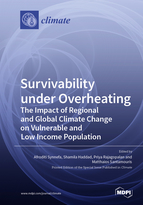Survivability under Overheating - The Impact of Regional and Global Climate Change on Vulnerable and Low Income Population
A special issue of Climate (ISSN 2225-1154).
Deadline for manuscript submissions: closed (31 August 2020) | Viewed by 180739
Special Issue Editors
Interests: innovative materials; urban climate change and heat mitigation technologies; energy-efficient buildings; sustainable energy technologies and energy saving technologies in buildings and settlements
Special Issues, Collections and Topics in MDPI journals
Interests: indoor environmental quality; urban heat island mitigation; urban microclimate; social housing; energy poverty; thermal comfort; indoor air quality; building energy efficiency; public health; post-occupancy evaluation
Special Issues, Collections and Topics in MDPI journals
Interests: urban microclimate; urban heat island; mitigation and adaptation; energy performance and benchmarking; indoor environmental quality
Special Issues, Collections and Topics in MDPI journals
Interests: energy and buildings; urban heat island; building science; urban physics; urban climate
Special Issues, Collections and Topics in MDPI journals
Special Issue Information
Dear Colleagues,
Urban overheating is a serious problem for the whole world. Although the so-called urban heat island phenomenon has been known for more than 100 years, the rapid urbanization combined with a continuous increase of the produced and released anthropogenic heat in cities has intensified the magnitude of the phenomenon and aggravated the impact on energy, the environment, comfort, and health. In addition, global climate change, causing an important increase in the frequency, magnitude, and duration of extreme heat events, seems to intensify the magnitude of the UHI phenomenon, especially during the period of heat waves because of the important synergetic effects.
Energy poverty refers to the conditions where households are not able to cover their basic energy needs. Energy poverty is very strongly related to energy conditions and characteristics and the local climate change. Houses of low energy quality, not well protected and presenting a high energy consumption, are a serious burden for low-income populations, as the required budget to satisfy proper indoor temperature conditions is usually high and cannot be afforded by the family income. In parallel, it is well known that low-income populations mainly live in quite deprived and degraded urban areas, where the phenomenon of the urban heat island is quite strong. Higher summer outdoor temperatures increase the vulnerability of the low-income population and put their health conditions under stress.
The development of appropriate mitigation and adaptation technologies to upgrade the environmental and climatic conditions in deprived urban zones and improve the energy performance and indoor environmental quality of low-income households seems to be the most important technological response to the problem.
The proposed Special Issue aims to cover the following subjects :
- Surveys and experimental data from low-income households during overheating conditions;
- Survivability analysis under current and future conditions for low-income households;
- Energy poverty data and analysis;
- Energy, health, comfort, IAQ, and economic issues related to overheated households;
- Development and implementation of appropriate mitigation technologies for deprived urban areas;
- Development and implementation of advanced low-cost adaptation technologies and strategies for low-income houses;
- Analysis of the interaction and impact of global and regional climate change in deprived urban zones;
- Case studies on mitigation and adaptation policies to alleviate energy poverty;
- Energy market transformation and policies that influence energy poverty;
- Case studies on the use of renewable technologies by low-income populations;
- Global challenges for the future: Energy security, climate change, and energy poverty;
- Thermal adaptation and physiology of acclimation in low-income populations during overheating conditions.
Dr. Afroditi Synnefa
Dr. Shamila Haddad
Dr. Priya Rajagopalan
Prof. Matthaios Santamouris
Guest Editors
Manuscript Submission Information
Manuscripts should be submitted online at www.mdpi.com by registering and logging in to this website. Once you are registered, click here to go to the submission form. Manuscripts can be submitted until the deadline. All submissions that pass pre-check are peer-reviewed. Accepted papers will be published continuously in the journal (as soon as accepted) and will be listed together on the special issue website. Research articles, review articles as well as short communications are invited. For planned papers, a title and short abstract (about 100 words) can be sent to the Editorial Office for announcement on this website.
Submitted manuscripts should not have been published previously, nor be under consideration for publication elsewhere (except conference proceedings papers). All manuscripts are thoroughly refereed through a single-blind peer-review process. A guide for authors and other relevant information for submission of manuscripts is available on the Instructions for Authors page. Climate is an international peer-reviewed open access monthly journal published by MDPI.
Please visit the Instructions for Authors page before submitting a manuscript. The Article Processing Charge (APC) for publication in this open access journal is 1800 CHF (Swiss Francs). Submitted papers should be well formatted and use good English. Authors may use MDPI's English editing service prior to publication or during author revisions.
Keywords
- energy poverty and climatic change
- vulnerable urban population survivability
- mitigation and adaptation of buildings
- social aspects of urban poverty
- future climatic projections and impact on low-income populations








